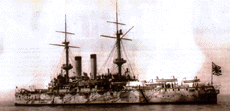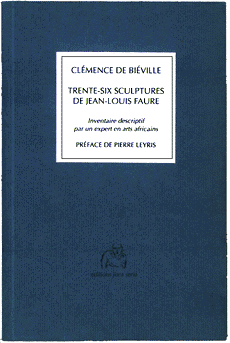|

Oak, beech, mirror, enamel and oilclothe.
H.95, W.180, D.46 cm (1984).

"Borodino"on fire.

The "Fuji" that sink the "Borodino" in Tsushima.

Clémence
de Biéville
Trente-six sculptures de Jean-Louis Faure
Editions joca seria.
|
|
This curious piece of furniture was offered by Admiral Togo, the victor
of Tsushima - a naval battle which changed AsiaŐs fate - to
Elie Faure (see sculpture 76) in September
1931.
One must remember that Japan, which came out of the Dark Ages in just
forty years, is impatient to impose its zone of influence to self-assured
and domineering Western powers. Russia is the most troublesome for the
moment, so close, arrogant, and so weak.
A modern army is ready. The fleet, built and trained in England under
the orders of Admiral Togo, is waiting for its hour.
In an augury of Pearl Harbor, in early 1904, the Japanese destroy the
Russian Pacific fleet at Port Arthur. After repeated military disasters,
the Czar decides to send out the Baltic fleet, which, over eight months,
will tour around Europe, Africa, go up the Indian Ocean and, by way of
the China Sea, its hulls weighed down with shells and its machines exhausted,
reach Tsushima Island, where a parading Togo sinks it without loosing
a single ship. This is the man Elie Faure wishes to meet, for to him he
is a hero of his youth, a new Nelson. Solicited by the French Embassy
at the end of 1930, the Admiral accepts the idea of a meeting in the following
year.
But this old man laden with glory is a complex personage. Retired and
bored stiff, he decides one day, at over seventy years old, to imagine
furniture pieces which he has drawn up by a flag lieutenant. The making
of the pieces is left to a shipŐs carpenter, the son of a childhood friend.
The first piece, a small dresser, is offered to Emperor Yoshi-Ito in 1918.
Until his death, in 1934, the Admiral will order fourteen pieces to be
made, including the one presented here - the only one to have left
Japan. In 1935, Hirohito asked the Diet to promulgate a law forbidding
the export of what is know as "Togo's thirteen marvels". These pieces
obtain fabulous prices when they are put up for sale. Three are still
in circulation, the others are in museums.
These pieces are destined to be offered to the Admiral's high quality
guests, all of which are Japanese. We believe we know why an exception
was made for Elie Faure: it is thanks to a memory Togo related to him.
In 1885, during the Franco-Chinese war, Togo, commanding the Amagi,
was on his way to Formosa to visit Admiral Courbet. As Togo wished to
visit the Ki-Long base, Courbet entrusted him to a 33-year-old military
engineer whom he found very sympathetic. The feeling was mutual and Marshal
Joffre (for it was he the young engineer), to whose widow the author was
introduced by his uncle (see sculpture 77)
in 1938, later inquired after the young navy officer whom he guided around
the Formosa arsenal when he was invited to the Imperial Palace in Tokyo.
One can imagine that it is this pleasant contact with France which prompted
Togo, 45 years later to conceive "Hokusai or the optical antipody" for
a French writer.
Togo gets in touch then with the Ambassador, Damien de Martel, to have
French culture explained to him and to be furnished with documents. This
old man is tireless. At the beginning of 1931, he begins to see the pieceŐs
broad lines. On May 1, the day the author is born, the plans are ready
and the carpenter can sit down to work.
Very soon, upon seeing Louis DavidŐs drawing (see sculpture 67)
representing Marie-Antoinette on her way to the guillotine, the Admiral
decides to make this sketch the feature element of a low table armed with
a white enamel protruding prow framed in oak. Togo was struck by the stunning
similitude of style between the David of the Terror and the Hokusai of
1793. He goes and finds the great
Japanese's signature from that year (for Hokusaï kept changing
his signature throughout his lifetime) as well as the seal of his publisher
at the time. Then he has sent over a block of oak, cut at the time of
the Revolution, from Aveyron (France) by the fastest torpedo, and passes
it on to a sculptor friend , asking him to copy Marie-Antoinette's pose
sitting in the cart. Set behind the prow, in the forward direction, the
tiny sculpture is reflected in
a mirror. At its feet, on a blue enamel plaque, a reversed typography,
in white, can be read straight in the mirror. This stems from a memory
of young Togo's stay in London at the time of Victoria. The signs on the
lawn read: "Trespass Will Lead To Prosecution". The work is finished
in early September and, on the 19th, the Admiral receives Elie Faure in
his house in a working-class area of Tokyo. At the end of a short one-hour
talk, during which time the Admiral does not seem much inclined to talk
about the battle, but rather about French art, and just at the moment
when the writer rises to leave, the living-room panel door slides open,
letting through four sailors in full regalia who set down in the middle
of the room the Hokusai table. The intepreter translates for the stunned
Elie Faure a short but very eloquent homage on behalf of the Admiral,
which ends with the offer to send the torpedo back to Marseilles with
the table while the French writer goes on with his trip.
In 1937, respectful of his last wishes, Elie Faure's family bequeaths
the famous object to the Musée Guimand.
|